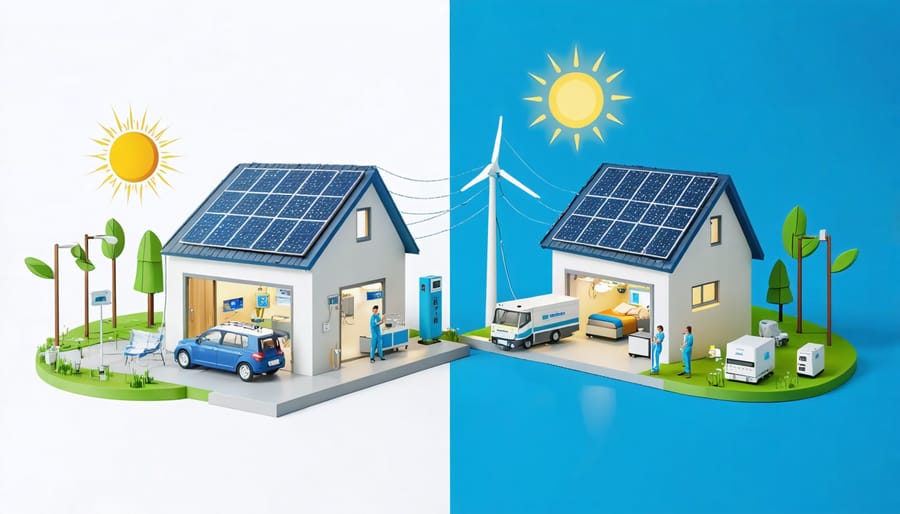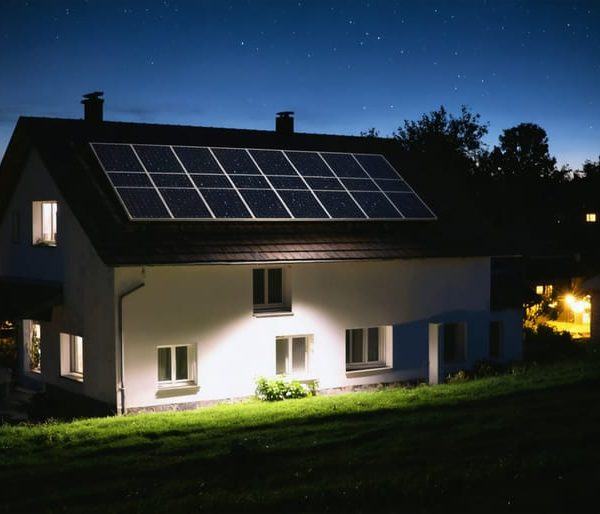Solar-Powered Medical Equipment That Could Save Your Life During Emergencies
Medical emergencies strike without warning, demanding swift action and reliable backup systems to maintain critical care. When traditional power fails, solar emergency power systems become lifelines for essential medical equipment and life-support devices.
Common medical emergency scenarios require immediate attention: cardiac arrests necessitating defibrillator access, respiratory failures demanding ventilator support, and critical care patients depending on powered monitoring equipment. Having a robust backup power solution isn’t just recommended—it’s essential for survival.
Healthcare facilities, home care settings, and emergency response teams must prepare for these scenarios by implementing reliable power backup solutions. Whether it’s maintaining refrigeration for temperature-sensitive medications, powering diagnostic equipment, or keeping vital signs monitors operational, the right emergency power system can mean the difference between life and death.
This guide explores practical emergency scenarios and provides actionable steps to ensure continuous medical care when conventional power sources fail.
Common Medical Emergency Scenarios at Home
Power-Dependent Medical Conditions
Several medical conditions require continuous access to powered medical equipment for patient survival and well-being. Sleep apnea patients rely on CPAP machines for consistent breathing during sleep, while individuals with chronic respiratory conditions need powered nebulizers and oxygen concentrators. Dialysis patients require reliable power for their life-sustaining treatments, which can last several hours.
Temperature-sensitive medications, such as insulin for diabetes management, must be stored in powered refrigeration units to maintain effectiveness. People with mobility challenges often depend on powered wheelchairs and lift systems for daily activities. Critical care patients may need ventilators, heart monitors, and infusion pumps operating around the clock.
During power outages, these essential medical devices become vulnerable, potentially putting patients at risk. Having a backup power solution is crucial for these scenarios. While traditional generators have been common backup options, solar power systems with battery storage are becoming increasingly popular due to their reliability, clean operation, and ability to provide sustainable emergency power when needed most.
Regular maintenance and testing of backup power systems ensure they’ll function properly during emergencies, giving peace of mind to patients and caregivers alike.
Natural Disaster Medical Needs
Natural disasters can severely disrupt healthcare services, making reliable emergency medical response crucial for survival. During events like hurricanes, earthquakes, or severe storms, standard power sources often fail, affecting critical medical equipment and life-support systems. Common medical needs during these situations include power for oxygen concentrators, medication refrigeration, and essential monitoring devices.
To prepare for such scenarios, consider having backup power solutions for medical devices, a well-stocked first aid kit, and at least a week’s supply of essential medications. Keep important medical documents in waterproof containers and create a list of emergency contacts including healthcare providers. For those requiring powered medical equipment, investing in solar-powered backup systems can provide reliable energy when traditional power sources fail.
Remember to regularly check and update emergency supplies, especially items with expiration dates. Having a basic understanding of first aid and CPR can also make a significant difference when professional medical help is temporarily unavailable.

Essential Solar-Powered Medical Equipment

Life-Support Equipment
When facing medical emergencies, having reliable power for life-support equipment is crucial. Modern medical devices like ventilators, oxygen concentrators, and dialysis machines require constant electricity to function properly. Solar backup systems offer a dependable solution for keeping these vital devices running during power outages.
A typical solar backup system for medical equipment includes solar panels, batteries, and an inverter specifically designed for medical-grade power requirements. These systems can be configured to automatically switch on when grid power fails, ensuring uninterrupted operation of critical devices.
For oxygen concentrators, which typically consume 350-400 watts per hour, a solar system with 1kW capacity and adequate battery storage can provide reliable backup power. Ventilators, requiring 200-300 watts, can run efficiently on similar setups. CPAP machines, essential for sleep apnea patients, use even less power and are particularly well-suited for solar backup solutions.
When setting up a solar backup system for medical equipment, it’s essential to:
– Calculate total power requirements for all devices
– Include extra capacity for emergency situations
– Install medical-grade surge protectors
– Regularly test the backup system
– Maintain battery health
Many healthcare facilities are now incorporating solar backup systems into their emergency preparedness plans, providing peace of mind for patients relying on life-support equipment. For home medical care, portable solar generators offer an additional layer of security during power emergencies.
Monitoring and Diagnostic Devices
Modern solar-powered monitoring and diagnostic devices have revolutionized emergency medical care, making it possible to maintain crucial health oversight even during power outages. These devices include portable vital sign monitors, pulse oximeters, and blood pressure machines that can run on solar-charged batteries.
A basic solar emergency medical kit typically includes a compact vital signs monitor that can track heart rate, blood pressure, and oxygen levels. These devices usually require minimal power and can operate for extended periods on a single charge from a small solar panel. Many models come with backup battery systems that can store enough power for several days of continuous operation.
For more comprehensive monitoring, solar-compatible ECG machines and respiratory monitors are available. These devices are particularly valuable for patients with chronic conditions who require constant monitoring. The latest models feature energy-efficient designs and can operate on hybrid power systems, seamlessly switching between solar and stored power.
Temperature monitoring devices and blood glucose meters with solar charging capabilities are also essential components. These portable units often include data storage and transmission features, allowing healthcare providers to track patient conditions remotely even during emergencies.
When selecting solar-powered medical monitoring equipment, look for devices with low power consumption, durable construction, and reliable backup power options. Many modern units also include USB charging capabilities, providing flexibility in power sources during emergency situations.
Setting Up Your Solar Medical Backup System
Power Requirements and System Sizing
Calculating the right power requirements for medical equipment during emergencies is crucial for maintaining continuous care. Start by listing all essential medical devices and their power consumption in watts. Common equipment like oxygen concentrators typically require 300-400 watts, while patient monitors need 50-100 watts. Add these values together to determine your base power needs.
When setting up solar backup systems, always include a 20% buffer for unexpected power surges and additional equipment. For example, if your total medical equipment needs are 1,000 watts, aim for a 1,200-watt system capacity.
Consider running times as well. Multiply your total wattage by the number of hours you need power. If you need 1,200 watts for 12 hours, you’ll require 14.4 kilowatt-hours of daily energy. Factor in weather conditions and seasonal changes that might affect solar panel efficiency.
Battery storage is equally important. Choose batteries that can store 1.5 times your daily energy needs to ensure backup power during cloudy days. For our example, that’s 21.6 kilowatt-hours of battery capacity. Deep-cycle batteries are recommended for their reliability and longer lifespan.
Remember to account for inverter efficiency, which typically ranges from 90-95%. If your medical equipment requires 1,200 watts, select an inverter rated at least 1,500 watts to compensate for conversion losses and provide stable power output.

Maintenance and Testing
Regular maintenance and testing of your medical emergency equipment is crucial for ensuring reliability when you need it most. Schedule monthly checks of all solar-powered medical devices, including backup batteries, solar panels, and charging systems. Keep a detailed maintenance log to track performance and identify potential issues before they become critical.
Test your emergency power system quarterly by simulating a power outage. This helps verify that all medical equipment switches seamlessly to solar backup power. During these tests, monitor battery charge levels and charging efficiency to ensure optimal performance. Clean solar panels monthly to maintain maximum power generation capacity, and inspect all wiring connections for signs of wear or damage.
For critical medical devices, implement a weekly testing protocol. This should include running devices on battery power for short periods, checking display functions, and verifying alarm systems are working correctly. Replace backup batteries according to manufacturer recommendations, typically every 2-3 years, even if they appear to be functioning well.
Create a maintenance checklist that includes:
– Visual inspection of all components
– Testing of backup power systems
– Cleaning of solar panels and equipment
– Verification of charging systems
– Check of all emergency protocols
– Documentation of test results
Remember to train all household members or facility staff on maintenance procedures and emergency protocols. This ensures everyone knows how to perform basic checks and respond to equipment issues.
In today’s rapidly changing world, the integration of solar-powered medical equipment into emergency preparedness plans isn’t just an eco-friendly choice – it’s a critical lifeline. As we’ve explored throughout this article, having reliable backup power for essential medical devices can mean the difference between life and death during emergencies.
Solar-powered solutions offer unique advantages that traditional backup systems can’t match. They provide sustainable, renewable energy that won’t run out as long as the sun shines, require minimal maintenance, and operate silently without harmful emissions. This makes them ideal for both urban and remote healthcare settings.
The success stories we’ve shared demonstrate how solar power has already saved lives during natural disasters, power outages, and other emergency situations. From powering oxygen concentrators to keeping vital medications refrigerated, these systems have proven their worth time and time again.
Remember, implementing solar-powered medical equipment isn’t just about having the technology – it’s about being prepared. Regular maintenance, proper training, and periodic testing of your solar system are essential steps in ensuring it will work when you need it most.
By embracing solar-powered medical equipment solutions, we’re not just preparing for emergencies – we’re investing in a more resilient and sustainable future for healthcare. The time to act is now, before the next emergency strikes.











